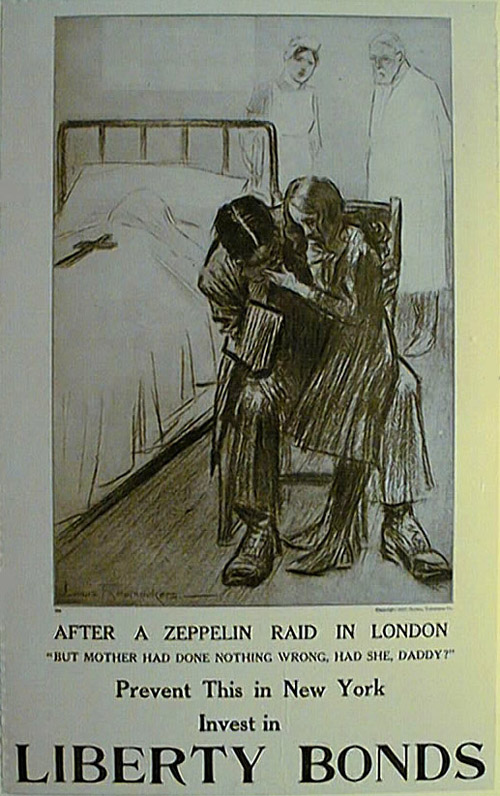
Anonymous (after Louis Raemaekers)
Untitled (After a zeppelin raid), 1917
offset lithograph mounted on board
17 3/8 x 10 7/8 in. (sheet); 18 x 11 1/2 in. (board)
95.3.11
Return to image index
|
|
This poster targets American civilians as it shows that tragedies in war occur not only on the battlefield but in towns and cities. Anyone can be a victim. The poster aims to touch Americans' sense of justice and compassion. A civilian woman has been killed in a London Zeppelin raid, and her husband and daughter grieve by her hospital bed. New technology that no one has seen before is being used in this war; it is frightening that a blimp could pass over the city at night and drop bombs on unaware citizens. The dress of the husband and the child indicates that they are most likely a middle-class Christian family, likely the intended audience of the poster. The daughter's face and the cross laid upon her mother's bed impart a sense of innocence and sacrifice. There is injustice in her mother's death; she was a civilian who believed she was safe from the war. The husband bent over crying also touches us, as we civilians can see this war is tearing families apart. Such images of innocent women, mothers of the nation, dying at the hand of the enemy create a sense of helplessness in the viewer. Looking at this tragic picture makes Americans want to be active in the war and to protect their families. The written message identifies this tragedy as a result of a raid in London. It then asks American citizens to picture this happening in the United States. "Prevent this in New York" is aimed to frighten the viewer, especially the male civilian who wants to protect his wife and children. The viewer can almost hear the girl's small voice asking her father, "But Mother had done nothing wrong, had she, Daddy?" The poster is effectively designed to motivate American family men. These men do not want to have to explain the injustice of war to their daughters. Buying Liberty Bonds is advertised as something anyone could do to contribute to the war effort if they cannot be on the battlefield. This type if war bond poster places "less emphasis on the investment value of buying than on the opportunity for civilians to aid the war effort directly." (1) The poster is trying to convey that the American civilians have a role in this war and that they can do something to protect their family. 1. Peter Paret, Beth Irwin, and Paul Paret, Persuasive Images:
Posters of War and Revolution from the Hoover Institution Archives
(Princeton: Princeton University Press, 1992).
|